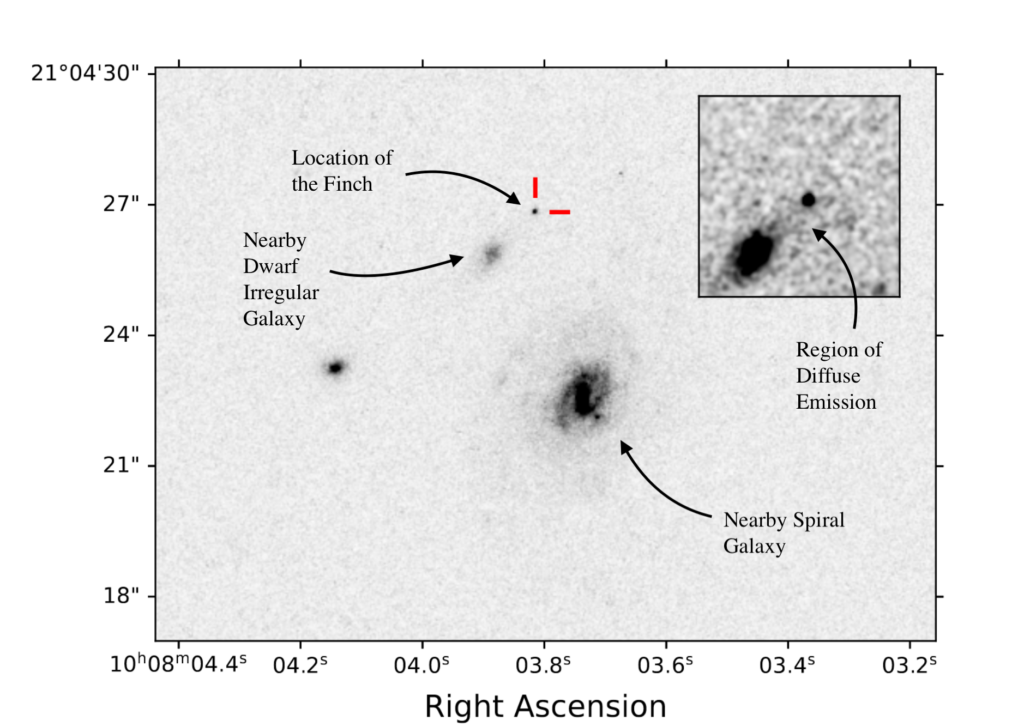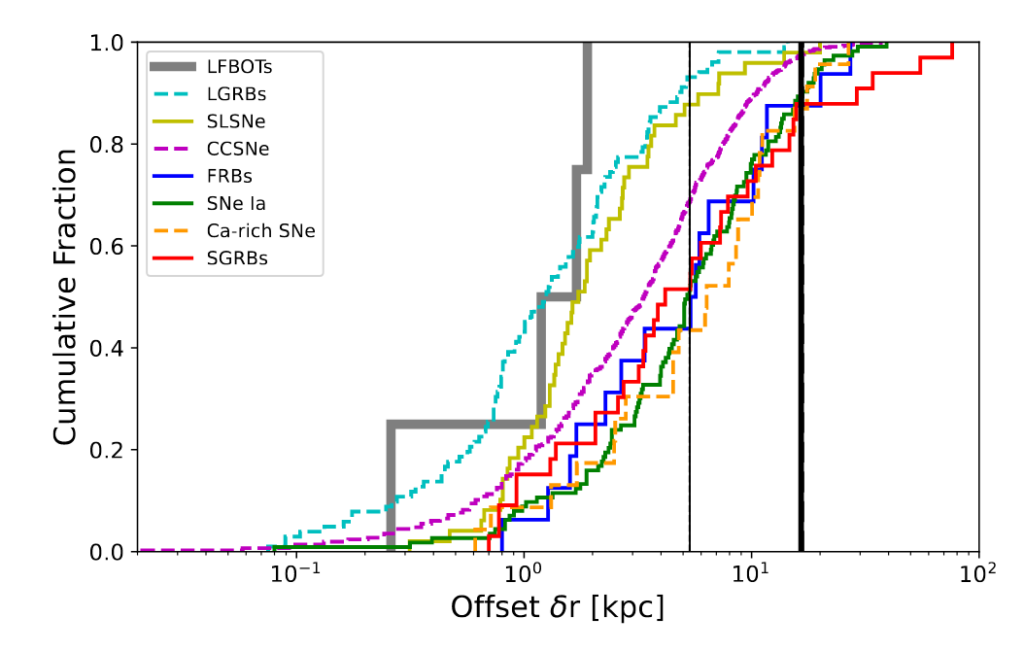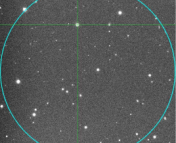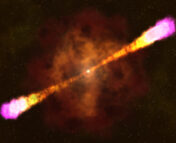Title: AT2023fhn (the Finch): a Luminous Fast Blue Optical Transient at a large offset from its host galaxy
Authors: A. A. Chrimes, P. G. Jonker, A. J. Levan, D. L. Coppejans, N. Gaspari, B. P. Gompertz, P. J. Groot, D. B. Malesani, A. Mummery, E. R. Stanway, K. Wiersema
First Author’s Institution: Department of Astrophysics/IMAPP, Radboud University, The Netherlands
Status: Submitted to MNRASL [closed access]
Astronomers love zoos. You might have heard of the supernova zoo or the Galaxy Zoo, but today’s paper is interested in the lesser-known but equally-perplexing Luminous, Fast, Blue, Optical Transient zoo, or the LFBOT zoo for short!
LFBOTs are a class of astronomical transients that are characterised by bright and rapid evolution that rises and fades within a few days, a blue colour, and featureless blackbody-like spectra with temperatures greater than 104 K.
So far, the LFBOT zoo only has a few members. These include the archetypal ‘Cow’ (AT2018cow, which you can read about here) plus the later additions of the ‘Koala’ (ZTF18abvkwla), the ‘Camel’ (ZTF20acigmel), and the ‘Tasmanian Devil’ (AT 2022tsd), among others. However, the newest LFBOT on the scene is AT2023fhn, nicknamed the ‘Finch’, which was discovered on the 10th of April 2023 using Zwicky Transient Facility data.
Given that only a handful of LFBOTs are known to astronomers, their exact nature continues to be a mystery. Several progenitor scenarios have been suggested, including black hole accretion or neutron star spin-down following the death of a massive star, the merger of stellar-mass black holes and hydrogen-poor stars, or the tidal disruption of white dwarfs by intermediate-mass black holes. With the goal of demystifying LFBOTs, the authors of today’s paper embarked on an in-depth analysis of the Finch.
Searching for a Host
First, the authors attempted to identify the Finch’s host galaxy. This is important to know for any transient as it shows the environments in which these events tend to occur, which can then help to constrain the progenitor objects.

To do this, the authors used Hubble Space Telescope observations, one of which is shown in Figure 1. The observation clearly identifies the location of the Finch, but also resolves two potential nearby host galaxies, namely a barred spiral galaxy to the south and a slightly closer dwarf irregular galaxy. For more information on galaxy morpholgies, check out this astrobite!
This was where things became a bit odd. The authors calculated the distance from the Finch to the two potential host galaxies, and determined values of 16.51 kiloparsec (kpc) for the spiral galaxy and 5.35 kpc for the dwarf irregular galaxy. These distances are large, making the Finch significantly more isolated than other identified LFBOTs, which have all been found in star-forming dwarf galaxies.
With this in mind, the authors calculated the probability of a chance alignment of the Finch and its potential hosts, determining values of 0.78% for the spiral galaxy and 1.38% for the dwarf galaxy. Therefore, it’s pretty likely that the progenitor of the Finch originated in one of these galaxies.
What does this mean for the progenitor?
Assuming the Finch was the result of the explosion of a massive star, one of the current hypotheses that tries to explain LFBOTs, the authors calculated how fast the star had to be travelling to get so far from either host before it died. For a long-lived, massive star that reaches an age of 100 million years, a velocity of 500 km/s is required, however only a small fraction of stars in the universe are observed to travel so fast. For a more typical star that lives to 10 million years, an even greater velocity is required, comparable to the fastest stars ever observed. Therefore, if a massive star from the nearby spiral or dwarf galaxy did produce the Finch, it had to be travelling extremely fast.
Next, the authors compared the offset of the Finch from the two potential hosts to offsets of other transients from their respective hosts. These results are presented in Figure 2, which gives the host-offset cumulative distribution for different classes of transients, or more simply, the fraction of a given type of transient that are located within a certain offset distance. The distribution for other LFBOTs is shown as the thick grey line, while the offset of the Finch from the nearby spiral and dwarf galaxies are shown as the thick and thin black lines, respectively.

Evidently, the offset of the Finch from its host in either scenario is significantly greater than the rest of the LFBOT population. In addition, the calculated offsets of the Finch lie in the extreme tails of the distributions for other massive star transients, including core-collapse supernovae (CCSNe), superluminous supernovae (SLSNe) and long gamma-ray bursts (LGRBs), and are in better agreement with the distributions for fast radio bursts (FRBs), calcium-rich supernovae (Ca-rich SNe) or binary neutron star mergers, also referred to as short gamma-ray bursts (SGRBs). Therefore, the authors suggest that the Finch may have a different physical origin to other LFBOTs and may not originate from a massive-star progenitor.
One possibility they give is the delayed merger of a lower-mass star and a compact object, such as a neutron star or black hole. This would enable the binary system to travel the large distance from either host to the location of the Finch at a reasonable velocity, since the system would not be limited by the short lifetime of massive stars.
Alternatively, the authors identified a region of diffuse emission in Hubble Space Telescope observations that may have given birth to the progenitor of the Finch, which can be seen in the inset of Figure 1. However, their analysis of these observations suggests a lack of young, bright stars, indicating an ageing stellar population. While this does not favour a massive star model for the Finch due to the short lifetimes of massive stars, it still allows for the possibility of a long-lived progenitor travelling at a low velocity.
Finally, the authors suggest that the Finch might lie in a smaller collection of stars that was too faint and too small to be seen in their observations, such as a globular cluster. Under this assumption, the authors proposed an intermediate black hole tidal disruption event as the likely culprit.
Clearly, the distance of the Finch from its two possible host galaxies makes it a special member of the LFBOT zoo, casting doubt on the uniformity of LFBOTs as a whole. With future observations and modelling, the Finch’s origins are likely to become clearer, but for that we’ll have to wait. At least for now, the Finch appears to have evolved separately to the Cow and the other animals in the LFBOT zoo.
Astrobite edited by Keighley Rockcliffe
Featured image credit: Wikimedia Commons




